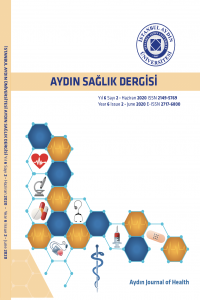MEDİAL AYAK AĞRISI NEDENİ: AKSESUAR NAVİKÜLER KEMİK
Ağrı, Rehabilitasyon, Aksesuar Naviküler Kemik
A CAUSE OF MEDIAL FOOT PAIN: ACCESSORY NAVICULAR BONE
Pain, Rehabilitation, Accessory Navıcular Bone,
___
- Bayram, S., & Kara, M. (2021). Relationship Between the of Type of Accessory Navicular Bone and Radiological Parameters of the Foot. Journal of the American Podiatric Medical Association, 21, 20-231.
- Chuang, Y. W., Tsai, W. S., Chen, K. H., & Hsu, H. C. (2012). Clinical use of high-resolution ultrasonography for the diagnosis of type II accessory navicular bone. American Journal of Physical Medicine & Rehabilitation, 91(2), 177-181.
- Coskun, N. K., Arican, R. Y., Utuk, A., Ozcanli, H., & Sindel, T. (2009). The incidence of accessory navicular bone types in Turkish subjects. Surgical and Radiologic Anatomy, 31(9), 675-679.
- Jegal, H., Park, Y. U., Kim, J. S., Choo, H. S., Seo, Y. U., & Lee, K. T. (2016). Accessory Navicular Syndrome in Athlete vs General Population. Foot Ankle International, 37(8), 862-7.
- Kara, M., & Bayram, S. (2021). Effect of Unilateral Accessory Navicular Bone on Radiologic Parameters of Foot. Foot Ankle International, 42(4), 469-475.
- Keles-Celik, N., Kose, O., Sekerci, R., Aytac, G., Turan, A., & Güler, F. (2017). Accessory Ossicles of the Foot and Ankle: Disorders and a Review of the Literature. Cureus, 9(11), e1881.
- Kır, H., Kandemir, S., Olgaç, M., Yıldırım, O., & Şen, G. (2011). Ayaktaki aksesuar kemiklerin görülme sıklığı ve dağılımı. Şişli Etfal Hastanesi Tıp Bülteni, 45(2), 44-47.
- Kopp, F.J., & Marcus, R.E. (2004). Clinical outcome of surgical treatment of the symptomatic accessory navicular. Foot Ankle International, 25(1), 27-30.
- Lee, J. H., Kyung, M. G., Cho, Y. J., Go, T. W., & Lee, D. Y. (2020). Prevalence of Accessory Bones and Tarsal Coalitions Based on Radiographic Findings in a Healthy, Asymptomatic Population. Clinics in Orthopedic Surgery, 12, 245-251.
- ISSN: 2149-5769
- Yayın Aralığı: Yılda 3 Sayı
- Başlangıç: 2015
- Yayıncı: İstanbul Aydın Üniversitesi
OTİZM TANISI ALMIŞ ÇOCUKLARIN AİLELERİNDE GÖRÜLEN PSİKO-SOSYAL SORUNLARIN DEĞERLENDİRMESİ
Mustafa KÖKSAL, Jade Cemre ERCİYES
ÜLKEMİZDE HASTA GÜVENLİĞİ KONUSU İLE İLGİLİ YAPILAN ARAŞTIRMALARIN BAZI ÖZELLİKLERİ
Gülşen ULAŞ KARAAHMETOĞLU, Gamze KAŞ
Trombositten Zengin Plazma Uygulaması Sonrası Gelişen Septik Artrit: İlk Olgu
Serap SATIŞ, Ezgi TEMEL AFŞAR, Alparslan YETİŞGİN
Toplumsal Cinsiyet Algısı ve Ön Yargı LGBTİ+lara Yönelik Davranış ve Tutumlara Yönelik Bir Çalışma
Berfin Görkem ÇELİK, Jade Cemre ERCİYES
Assessment of the efficacy of spironolactone for COVID-19 ARDS patients
Aysin ERSOY, Bülent Barış GÜVEN, Tuna ERTÜRK, Fulya YURTSEVER, Zöhre KARAMAN, Temel GÜNER, Özge KÖMPE
MEDİAL AYAK AĞRISI NEDENİ: AKSESUAR NAVİKÜLER KEMİK
Nazlı KARAMAN, Yasemin ÖZKAN, Hilal TELLİ
Üreme Çağındaki Kadınlarda Obezite ve Ebelik Bakımı
Double pylorus; report of a case
